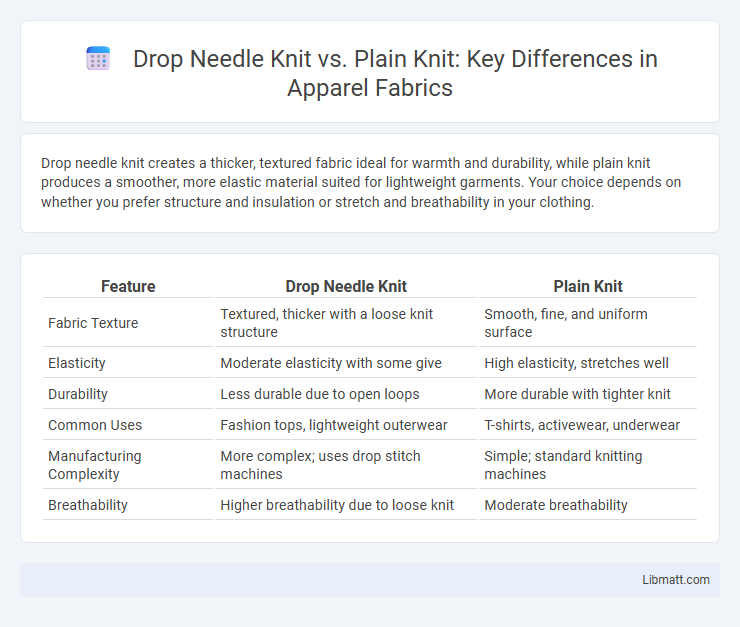Drop needle knit creates a thicker, textured fabric ideal for warmth and durability, while plain knit produces a smoother, more elastic material suited for lightweight garments. Your choice depends on whether you prefer structure and insulation or stretch and breathability in your clothing.
Table of Comparison
| Feature | Drop Needle Knit | Plain Knit |
|---|---|---|
| Fabric Texture | Textured, thicker with a loose knit structure | Smooth, fine, and uniform surface |
| Elasticity | Moderate elasticity with some give | High elasticity, stretches well |
| Durability | Less durable due to open loops | More durable with tighter knit |
| Common Uses | Fashion tops, lightweight outerwear | T-shirts, activewear, underwear |
| Manufacturing Complexity | More complex; uses drop stitch machines | Simple; standard knitting machines |
| Breathability | Higher breathability due to loose knit | Moderate breathability |
Introduction to Drop Needle Knit and Plain Knit
Drop needle knit creates a textured fabric by selectively dropping stitches on a knitting machine, resulting in an open, airy pattern ideal for lightweight garments. Plain knit, also known as single knit, produces a smooth, uniform surface with a consistent, flat texture commonly used in t-shirts and basic apparel. Both techniques vary in stitch structure and fabric density, influencing breathability and stretch.
Understanding Knit Fabric Construction
Drop needle knit features dropped stitches that create intentional gaps and a textured, airy fabric, while plain knit uses continuous loops forming a smooth, uniform surface ideal for durability and stretch. Understanding knit fabric construction helps you choose the right material for your project, balancing breathability and strength. Your fabric selection impacts comfort, appearance, and garment longevity based on these structural differences.
What is Plain Knit?
Plain knit, also known as jersey knit, is a basic knitting structure characterized by a series of interlocking loops that create a smooth, flat surface on one side and a textured, looped surface on the other. This fabric offers excellent stretch and breathability, making it ideal for everyday clothing such as t-shirts and casual wear. Understanding the simplicity and versatility of plain knit can help you choose the right material for comfort and durability in your garments.
What is Drop Needle Knit?
Drop needle knit is a textile technique where individual needles are intentionally dropped or skipped during the knitting process, creating deliberate holes and a textured, lace-like pattern. This method contrasts with plain knit, which produces a uniform, smooth fabric with all stitches formed consistently. Understanding drop needle knit can help you choose fabrics with unique breathability and aesthetic appeal for your designs or garments.
Key Differences Between Drop Needle Knit and Plain Knit
Drop needle knit features a textured, honeycomb-like structure created by specialized machines that drop needles selectively, resulting in garments with enhanced breathability and stretch. Plain knit, also known as jersey knit, has a smooth, flat surface achieved through continuous needle movement, offering a lightweight and uniform fabric ideal for t-shirts and casual wear. Understanding these key differences helps you choose the appropriate knit type for comfort, durability, and aesthetic preference in your clothing projects.
Texture and Appearance Comparison
Drop needle knit features an open, mesh-like texture with prominent loops that create a breathable and lightweight fabric, making it ideal for summer wear and layering. Plain knit, also known as jersey knit, offers a smooth, uniform surface with fine rows of interlocking loops, resulting in a soft and stretchy fabric commonly used for t-shirts and casual apparel. Understanding these differences in texture and appearance helps you choose the right knit type for your garment's desired look and comfort.
Performance and Durability Factors
Drop needle knit fabric exhibits enhanced durability due to its complex interlocking loop structure, which resists deformation and wear better than plain knit. Plain knit, while offering superior elasticity and softness, tends to be less resistant to abrasion and pilling over extended use. Performance-wise, drop needle knits provide greater dimensional stability and resilience, making them ideal for high-stress applications such as sportswear and outerwear.
Common Uses in Fashion and Textiles
Drop needle knit is favored in fashion for creating textured, durable fabrics often used in sweaters, scarves, and outerwear, offering a cozy, dimensional look. Plain knit, known for its smooth surface and stretch, is commonly used in t-shirts, leggings, and lightweight dresses, providing comfort and flexibility for everyday wear. Your choice between drop needle and plain knit fabrics impacts the garment's aesthetic and functional qualities, tailoring it to specific style and performance needs.
Pros and Cons: Drop Needle Knit vs Plain Knit
Drop needle knit offers a textured, patterned fabric that enhances breathability and stretch, making it ideal for activewear and fashion apparel; however, it often requires specialized machinery, increasing production costs. Plain knit provides a smooth, consistent fabric that is versatile and cost-effective for mass production, but it may lack the dimensional quality and ventilation found in drop needle knit. Both techniques serve distinct purposes, with drop needle knit excelling in design complexity and plain knit favored for simplicity and affordability.
Choosing the Right Knit for Your Project
Drop needle knit offers a textured and elastic fabric ideal for creating lightweight yet durable garments, making it perfect for activewear or casual clothing. Plain knit, characterized by its smooth surface and versatility, works well for projects requiring a clean appearance and moderate stretch, such as t-shirts or simple sweaters. Understanding the distinct qualities of drop needle and plain knit helps you choose the right fabric that aligns with your project's comfort, durability, and aesthetic needs.
Drop Needle Knit vs Plain Knit Infographic

 libmatt.com
libmatt.com